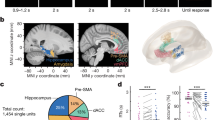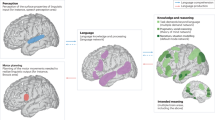Abstract
A central neuroscientific pursuit is understanding neuronal interactions that support computations underlying cognition and behavior. Although neurons interact across disparate scales, from cortical columns to whole-brain networks, research has been restricted to one scale at a time. We measured local interactions through multi-neuronal recordings while accessing global networks using scalp electroencephalography (EEG) in rhesus macaques. We measured spike count correlation, an index of functional connectivity with computational relevance, and EEG oscillations, which have been linked to various cognitive functions. We found a non-monotonic relationship between EEG oscillation amplitude and spike count correlation, contrary to the intuitive expectation of a direct relationship. With a widely used network model, we replicated these findings by incorporating a private signal targeting inhibitory neurons, a common mechanism proposed for gain modulation. Finally, we found that spike count correlation explained nonlinearities in the relationship between EEG oscillations and response time in a spatial selective attention task.
This is a preview of subscription content, access via your institution
Access options
Subscribe to this journal
Receive 12 print issues and online access
$209.00 per year
only $17.42 per issue
Buy this article
- Purchase on Springer Link
- Instant access to full article PDF
Prices may be subject to local taxes which are calculated during checkout








Similar content being viewed by others
References
Averbeck, B.B., Latham, P.E. & Pouget, A. Neural correlations, population coding and computation. Nat. Rev. Neurosci. 7, 358–366 (2006).
Kohn, A. & Smith, M.A. Stimulus dependence of neuronal correlation in primary visual cortex of the macaque. J. Neurosci. 25, 3661–3673 (2005).
Smith, M.A. & Kohn, A. Spatial and temporal scales of neuronal correlation in primary visual cortex. J. Neurosci. 28, 12591–12603 (2008).
Smith, M.A. & Sommer, M.A. Spatial and temporal scales of neuronal correlation in visual area V4. J. Neurosci. 33, 5422–5432 (2013).
Cohen, M.R. & Maunsell, J.H. Attention improves performance primarily by reducing interneuronal correlations. Nat. Neurosci. 12, 1594–1600 (2009).
Mitchell, J.F., Sundberg, K.A. & Reynolds, J.H. Spatial attention decorrelates intrinsic activity fluctuations in macaque area V4. Neuron 63, 879–888 (2009).
Gu, Y. et al. Perceptual learning reduces interneuronal correlations in macaque visual cortex. Neuron 71, 750–761 (2011).
Jeanne, J.M., Sharpee, T.O. & Gentner, T.Q. Associative learning enhances population coding by inverting interneuronal correlation patterns. Neuron 78, 352–363 (2013).
Snyder, A.C., Morais, M.J., Kohn, A. & Smith, M.A. Correlations in V1 are reduced by stimulation outside the receptive field. J. Neurosci. 34, 11222–11227 (2014).
Gregoriou, G.G., Gotts, S.J., Zhou, H. & Desimone, R. High-frequency, long-range coupling between prefrontal and visual cortex during attention. Science 324, 1207–1210 (2009).
Pesaran, B., Nelson, M.J. & Andersen, R.A. Free choice activates a decision circuit between frontal and parietal cortex. Nature 453, 406–409 (2008).
Logothetis, N.K., Pauls, J., Augath, M., Trinath, T. & Oeltermann, A. Neurophysiological investigation of the basis of the fMRI signal. Nature 412, 150–157 (2001).
Shmuel, A., Augath, M., Oeltermann, A. & Logothetis, N.K. Negative functional MRI response correlates with decreases in neuronal activity in monkey visual area V1. Nat. Neurosci. 9, 569–577 (2006).
Whittingstall, K. & Logothetis, N.K. Frequency-band coupling in surface EEG reflects spiking activity in monkey visual cortex. Neuron 64, 281–289 (2009).
Nunez, P.L. & Srinivasan, R. Electric Fields of the Brain: the Neurophysics of EEG (Oxford University, 2006).
Musall, S., von Pfostl, V., Rauch, A., Logothetis, N.K. & Whittingstall, K. Effects of neural synchrony on surface EEG. Cereb. Cortex 24, 1045–1053 (2014).
Renart, A. et al. The asynchronous state in cortical circuits. Science 327, 587–590 (2010).
van Vreeswijk, C. & Sompolinsky, H. Chaos in neuronal networks with balanced excitatory and inhibitory activity. Science 274, 1724–1726 (1996).
Mathewson, K.E., Gratton, G., Fabiani, M., Beck, D.M. & Ro, T. To see or not to see: prestimulus alpha phase predicts visual awareness. J. Neurosci. 29, 2725–2732 (2009).
Lakatos, P., Karmos, G., Mehta, A.D., Ulbert, I. & Schroeder, C.E. Entrainment of neuronal oscillations as a mechanism of attentional selection. Science 320, 110–113 (2008).
van Elswijk, G. et al. Corticospinal beta-band synchronization entails rhythmic gain modulation. J. Neurosci. 30, 4481–4488 (2010).
Womelsdorf, T. et al. Orientation selectivity and noise correlation in awake monkey area V1 are modulated by the gamma cycle. Proc. Natl. Acad. Sci. USA 109, 4302–4307 (2012).
de la Rocha, J., Doiron, B., Shea-Brown, E., Josic´, K. & Reyes, A. Correlation between neural spike trains increases with firing rate. Nature 448, 802–806 (2007).
Cohen, M.R. & Kohn, A. Measuring and interpreting neuronal correlations. Nat. Neurosci. 14, 811–819 (2011).
Palva, S. & Palva, J.M. New vistas for alpha-frequency band oscillations. Trends Neurosci. 30, 150–158 (2007).
Foxe, J.J. & Snyder, A.C. The role of alpha-band brain oscillations as a sensory suppression mechanism during selective attention. Front. Psychol. 2, 154 (2011).
Yuval-Greenberg, S., Tomer, O., Keren, A.S., Nelken, I. & Deouell, L.Y. Transient induced gamma-band response in EEG as a manifestation of miniature saccades. Neuron 58, 429–441 (2008).
Bosman, C.A., Womelsdorf, T., Desimone, R. & Fries, P. A microsaccadic rhythm modulates gamma-band synchronization and behavior. J. Neurosci. 29, 9471–9480 (2009).
Mitchell, J.F., Sundberg, K.A. & Reynolds, J.H. Differential attention-dependent response modulation across cell classes in macaque visual area V4. Neuron 55, 131–141 (2007).
Narayanan, R. & Johnston, D. Long-term potentiation in rat hippocampal neurons is accompanied by spatially widespread changes in intrinsic oscillatory dynamics and excitability. Neuron 56, 1061–1075 (2007).
Lindén, H., Pettersen, K.H. & Einevoll, G.T. Intrinsic dendritic filtering gives low-pass power spectra of local field potentials. J. Comput. Neurosci. 29, 423–444 (2010).
Manning, J.R., Jacobs, J., Fried, I. & Kahana, M.J. Broadband shifts in local field potential power spectra are correlated with single-neuron spiking in humans. J. Neurosci. 29, 13613–13620 (2009).
Miller, K.J. et al. Human motor cortical activity is selectively phase-entrained on underlying rhythms. PLoS Comput. Biol. 8, e1002655 (2012).
Ai, L. & Ro, T. The phase of prestimulus alpha oscillations affects tactile perception. J. Neurophysiol. 111, 1300–1307 (2014).
Lange, J., Halacz, J., van Dijk, H., Kahlbrock, N. & Schnitzler, A. Fluctuations of prestimulus oscillatory power predict subjective perception of tactile simultaneity. Cereb. Cortex 22, 2564–2574 (2012).
Linkenkaer-Hansen, K., Nikulin, V.V., Palva, S., Ilmoniemi, R.J. & Palva, J.M. Prestimulus oscillations enhance psychophysical performance in humans. J. Neurosci. 24, 10186–10190 (2004).
Zhang, Y. & Ding, M. Detection of a weak somatosensory stimulus: role of the prestimulus mu rhythm and its top-down modulation. J. Cogn. Neurosci. 22, 307–322 (2010).
Baron, R.M. & Kenny, D.A. The moderator-mediator variable distinction in social psychological research: conceptual, strategic, and statistical considerations. J. Pers. Soc. Psychol. 51, 1173–1182 (1986).
Houser, C.R., Hendry, S.H., Jones, E.G. & Vaughn, J.E. Morphological diversity of immunocytochemically identified GABA neurons in the monkey sensory-motor cortex. J. Neurocytol. 12, 617–638 (1983).
Buzsáki, G. & Chrobak, J.J. Temporal structure in spatially organized neuronal ensembles: a role for interneuronal networks. Curr. Opin. Neurobiol. 5, 504–510 (1995).
Disney, A.A., Aoki, C. & Hawken, M.J. Gain modulation by nicotine in macaque v1. Neuron 56, 701–713 (2007).
Disney, A.A., Aoki, C. & Hawken, M.J. Cholinergic suppression of visual responses in primate V1 is mediated by GABAergic inhibition. J. Neurophysiol. 108, 1907–1923 (2012).
Zohary, E., Shadlen, M.N. & Newsome, W.T. Correlated neuronal discharge rate and its implications for psychophysical performance. Nature 370, 140–143 (1994).
Kelly, R.C., Smith, M.A., Kass, R.E. & Lee, T.S. Local field potentials indicate network state and account for neuronal response variability. J. Comput. Neurosci. 29, 567–579 (2010).
Katzner, S. et al. Local origin of field potentials in visual cortex. Neuron 61, 35–41 (2009).
Goris, R.L., Movshon, J.A. & Simoncelli, E.P. Partitioning neuronal variability. Nat. Neurosci. 17, 858–865 (2014).
Pelli, D.G. The VideoToolbox software for visual psychophysics: transforming numbers into movies. Spat. Vis. 10, 437–442 (1997).
Kleiner, M., Brainard, D.H. & Pelli, D. What's new in Psychtoolbox-3? Perception 36, 18 (2007).
Brainard, D.H. The Psychophysics Toolbox. Spat. Vis. 10, 433–436 (1997).
Shoham, S., Fellows, M.R. & Normann, R.A. Robust, automatic spike sorting using mixtures of multivariate t-distributions. J. Neurosci. Methods 127, 111–122 (2003).
Kelly, R.C. et al. Comparison of recordings from microelectrode arrays and single electrodes in the visual cortex. J. Neurosci. 27, 261–264 (2007).
Acknowledgements
We are grateful to B. Doiron for helpful advice and discussion, and to S. Cortes and S. Nelson for help with data collection. A.C.S. was supported by a US National Institutes of Health fellowship (F32EY023456). M.J.M. was supported by an US National Institutes of Health undergraduate research training fellowship through the University of Pittsburgh's Program in Neural Computation (R90DA023426). M.A.S. was supported by US National Institutes of Health grants R00EY018894, R01EY022928 and P30EY008098, a career development grant and an unrestricted award from Research to Prevent Blindness, and the Eye and Ear Foundation of Pittsburgh.
Author information
Authors and Affiliations
Contributions
A.C.S. and M.A.S. designed the experiments, analyzed the data and wrote the manuscript. A.C.S. and C.M.W. conducted the experiments. A.C.S. and M.J.M. conducted the network model simulations. M.A.S. supervised the project.
Corresponding author
Ethics declarations
Competing interests
The authors declare no competing financial interests.
Integrated supplementary information
Supplementary Figure 1 Average power spectrum for estimated EEG signal derived by summing the EPSPs from the neural network model.
Average power spectrum for estimated EEG signal derived by summing the EPSPs from the neural network model (mean of 54,240 one-second epochs, SEM is contained within the line). Note that the vertical axis of volts is not a veridical representation of scalp EEG because it does not take into account tissue resistances. For this analysis, we had 1 Hz frequency resolution. When we calculated spike count correlation we separated each 1 s epoch of simulated data into five 200 ms epochs, which provided 5 Hz resolution for those analyses.
Supplementary Figure 2 EEG power spectra.
EEG power spectra (right central-parietal sensor) for Monkey W (top) and Monkey B (bottom). Shading represents ± 1 SEM.
Supplementary Figure 3 Task schematic.
Task schematic. While the subject maintained central fixation, a peripheral visual cue indicated the spatial location that was more likely to contain the target (80% validity). Subsequently, two drifting gratings appeared. The task was to detect a change in the drift speed in one of the two gratings, and to make an eye movement to this stimulus. On 40% of trials neither stimulus changed speed and the subject was rewarded for maintaining fixation. The dashed circle and “spotlight” symbol represent the receptive field area and focus of attention, respectively, and were not actually present in the stimulus display. For one subject, the cue was an isoluminant yellow annulus that encircled the aggregate RF area, while for the other subject (shown) the cue was a low-contrast dot at the center of the RF area.
Supplementary information
Supplementary Text and Figures
Supplementary Figures 1–3 (PDF 145 kb)
Rights and permissions
About this article
Cite this article
Snyder, A., Morais, M., Willis, C. et al. Global network influences on local functional connectivity. Nat Neurosci 18, 736–743 (2015). https://doi.org/10.1038/nn.3979
Received:
Accepted:
Published:
Issue Date:
DOI: https://doi.org/10.1038/nn.3979
This article is cited by
-
Enhancement of the neural response during 40 Hz auditory entrainment in closed-eye state in human prefrontal region
Cognitive Neurodynamics (2023)
-
Graph-generative neural network for EEG-based epileptic seizure detection via discovery of dynamic brain functional connectivity
Scientific Reports (2022)
-
Distractibility and impulsivity neural states are distinct from selective attention and modulate the implementation of spatial attention
Nature Communications (2022)
-
CNS Maturation Process in Children and Adolescents in the Northern Region of the Russian Federation and Its Reflection in the Dynamics of Integral EEG Parameters
Neuroscience and Behavioral Physiology (2022)
-
Decoding the influence of anticipatory states on visual perception in the presence of temporal distractors
Nature Communications (2018)



